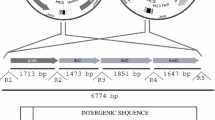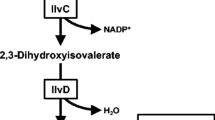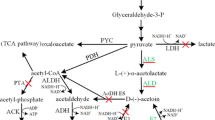Abstract
Isobutanol can be biosynthesized via α-ketoisovalerate catalyzed by heterologous keto acid decarboxylase (KDC) and alcohol dehydrogenase (ADH). In this work, isobutanol biosynthesis pathway was designed in Bacillus subtilis, a notable solvent-tolerant host. In order to do that, a plasmid pPKA expressing KDC and ADH under the control of a B. subtilis strong promoter P43 was constructed. Isobutanol was detected in the products of the recombinant B. subtilis harboring pPKA plasmid, whereas none was detected by the wild-type strain. Effects of the medium ingredients such as glucose concentration and valine addition, and operating parameters such as initial pH, inoculation volume, and medium work volume on isobutanol production were also investigated. Isobutanol production reached to the maximum of 0.607 g/L after 35-h cultivation under the conditions: glucose concentration of 3%, valine addition of 2%, initial pH of 7.0, inoculum of 1%, and work volume of 50 mL/250 mL. Though the isobutanol production by the recombinant was low, it was the first successful attempt to produce isobutanol in engineered B. subtilis, and the results showed its great potential as an isobutanol-producing cell factory.



Similar content being viewed by others
References
Atsumi, S., Hanai, T., & Liao, J. C. (2008). Non-fermentative pathways for synthesis of branched-chain higher alcohols as biofuels. Nature, 451, 86–90.
Potera, C. (2009). Forging isobutanol with modified microbes. Genetic Engineering & Biotechnology News, 29, 18/21.
Dickinson, J. R., Harrison, S. J., & Hewlins, M. J. E. (1998). An investigation of the metabolism of valine to isobutyl alcohol in Saccharomyces cerevisiae. The Journal of Biological Chemistry, 273, 25751–25756.
Dickinson, J. R., Lanterman, M. M., Danner, D. J., Pearson, B. M., Sanz, P., Harrison, S. J., et al. (1997). A 13C nuclear magnetic resonance investigation of the metabolism of leucine to isoamyl alcohol in Saccharomyces cerevisiae. The Journal of Biological Chemistry, 272, 26871–26878.
Fischer, C. R., Klein-Marcuschamer, D., & Stephanopoulos, G. (2008). Selection and optimization of microbial hosts for biofuels production. Metabolic Engineering, 10, 295–304.
Li, W. F., Zhou, X. X., & Lu, P. (2004). Bottlenecks in the expression and secretion of heterologous proteins in Bacillus subtilis. Research in Microbiology, 155, 605–610.
Yasbin, R. E., Wilson, G. A., & Young, F. E. (1975). Transformation and transfection in lysogenic strains of Bacillus subtilis: evidence for selective induction of prophage in competent Cells. Journal of Bacteriology, 121, 296–304.
Sambrook, J., & Russell, D. W. (2001). Molecular cloning: a laboratory manual. Cold Spring Harbor Laboratory: Cold Spring Harbor.
Anagnostopoulos, C., & Spizizen, J. (1961). Requirements for transformation in Bacillus subtilis. Journal of Bacteriology, 81, 741–746.
Gao, J., Xu, H., Li, Q. J., Feng, X. H., & Li, S. (2010). Optimization of medium for one-step fermentation of inulin extract from Jerusalem artichoke tubers using Paenibacillus polymyxa ZJ-9 to produce R, R-2,3-butanediol. Bioresource Technology, 101, 7076–7082.
Qin, J. Y., Wang, X. W., Zheng, Z. J., Ma, C. Q., Tang, H. Z., & Xu, P. (2010). Production of L-lactic acid by a thermophilic Bacillus mutant using sodium hydroxide as neutralizing agent. Bioresource Technology, 101, 7570–7576.
Connor, M. R., & Liao, J. C. (2009). Microbial production of advanced transportation fuels in non-natural hosts. Current Opinion in Biotechnology, 20, 307–315.
Sentheshammuganathan, S., & Elsden, S. R. (1958). The mechanism of the formation of tyrosol by Saccharomyces cerevisiae. The Biochemical Journal, 69, 210–218.
Smith, K. M., Cho, K. M., & Liao, J. C. (2010). Engineering Corynebacterium glutamicum for isobutanol production. Applied Microbiology and Biotechnology, 87, 1045–1055.
Nielsen, D. R., Leonard, E., Yoon, S. H., Tseng, H. C., Yuan, C., & Prather, K. L. J. (2009). Engineering alternative butanol production platforms in heterologous bacteria. Metabolic Engineering, 11, 262–273.
Wang, P. Z., & Doi, R. H. (1984). Overlapping promoters transcribed by Bacillus subtilis σ55 and σ37 RNA polymerase holoenzymes during growth and stationary phases. The Journal of Biological Chemistry, 259, 8619–8625.
Zheng, J. T., Wang, S. L., & Yang, K. Q. (2007). Engineering a regulatory region of jadomycin gene cluster to improve jadomycin B production in Streptomyces venezuelae. Applied Microbiology and Biotechnolgy, 76, 883–888.
Sun, H. G., Bie, X. M., Lu, F. X., Lu, Y. P., Wu, Y. D. L., & Lu, Z. X. (2009). Enhancement of surfactin production of Bacillus subtilis fmbR by replacement of the native promoter with the Pspac promoter. Canadian Journal of Microbiology, 55, 1003–1006.
Görke, B., & Stülke, J. (2008). Carbon catabolite repression in bacteria: many ways to make the most out of nutrients. Nature Review Microbiology, 6, 613–624.
Blencke, H. M., Homuth, G., Ludwing, H., Mäder, U., Hecker, M., & Stülke, J. (2003). Transcriptional profiling of gene expression in response to glucose in Bacillus subtilis: regulation of the central metabolic pathways. Metabolic Engineering, 5, 133–149.
Leyval, D., Uy, D., Delaunay, S., Goergen, J. L., & Engasser, J. M. (2003). Characterisation of the enzyme activities involved in the valine biosynthetic pathway in a valine-producing strain of Corynebacterium glutamicum. Journal of Biotechnology, 104, 241–252.
Yuzbashev, T. V., Yuzbasheva, E. Y., Sobolevskaya, T. I., Laptev, I. A., Vybornaya, T. V., Larina, A. S., et al. (2010). Production of succinic acid at low pH by a recombinant strain of the aerobic yeast Yarrowia lipolytica. Biotechnology and Bioengineering, 107, 673–682.
Holtzclaw, W. D., & Chapman, L. F. (1975). Degradative acetolactate synthase of Bacillus subtilis: purification and properties. Journal of Bacteriology, 121, 917–922.
Fang, X. L., Feng, J. T., Zhang, W. G., Wang, Y. H., & Zhang, X. (2010). Optimization of growth medium and fermentation conditions for improved antibiotic activity of Xenorhabdus nematophila TB using a statistical approach. African Journal of Biotechnology, 9, 8068–8077.
Chung, B. K. S., Selvarasu, S., Andrea, C., Ryu, J., Lee, H., Ahn, J., et al. (2010). Genome-scale metabolic reconstruction and in silico analysis of methylotrophic yeast Pichia pastoris for strain improvement. Microbioal Cell Factories, 9, 50–64.
Leonard, E., Runguphan, W., O’Connor, S., & Prather, K. J. (2009). Opportunities in metabolic engineering to facilitate scalable alkaloid production. Nature Chemical Biology, 5, 292–300.
Keasling, J. D., & Chou, H. (2008). Metabolic engineering delivers next-generation biofuels. Nature Biotechnology, 26, 298–299.
Schleifer, K. H., Kraus, J., Dvorak, C., Kilpper-Balz, R., Collins, M. D., & Fischer, W. (1985). Transfer of Streptococcus lactis and related streptococci to the genus Lactococcus gen. nov. Systematic and Applied Microbiology, 6, 183–195.
Acknowledgments
The authors appreciate the kind donation of the strain B. subtilis 168 and the plasmid pHP13 from Dr. Danier R. Zeigler and BGSC, the Ohio State University, OH, USA. The authors are also thankful to Prof. Pingsheng Ma, School of Chemical Engineering and Technology, Tianjin University, China, for the donation of the strain S. cerevisiae W303-1A. This research was financially supported by the National 973 Project of China (No. 2007CB714302), the National Natural Science Foundation of China (No. 20976124 and No. 20906070), the Innovation Foundation of Tianjin University, and the Program of Introducing Talents of Discipline to Universities (No. B06006).
Author information
Authors and Affiliations
Corresponding authors
Rights and permissions
About this article
Cite this article
Jia, X., Li, S., Xie, S. et al. Engineering a Metabolic Pathway for Isobutanol Biosynthesis in Bacillus subtilis . Appl Biochem Biotechnol 168, 1–9 (2012). https://doi.org/10.1007/s12010-011-9268-1
Received:
Accepted:
Published:
Issue Date:
DOI: https://doi.org/10.1007/s12010-011-9268-1




